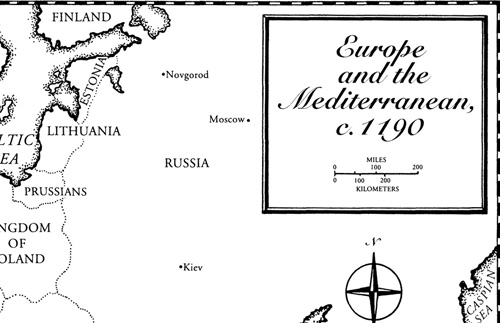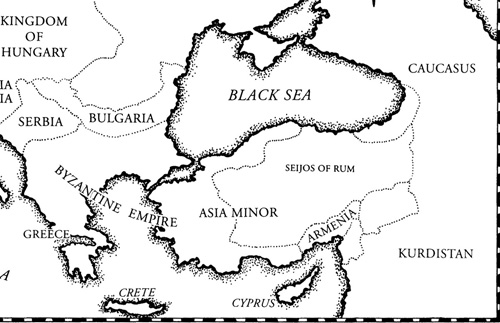A World Lit Only by Fire (5 page)
Read A World Lit Only by Fire Online
Authors: William Manchester





R
OYALTY WAS
invested with glory, swathed in mystique, and clothed with magical powers. To be a king was to be a lord of men, a host at
great feasts for his vassal dukes, earls, counts, barons, and marquises; a giver of rings, of gold, of landed estates. Because
the first medieval rulers had been barbarians, most of what followed derived from their customs. Chieftains like Ermanaric,
Alaric, Attila, and Clovis rose as successful battlefield leaders whose fighting skills promised still more triumphs to come.
Each had been chosen by his warriors, who, after raising him on their shields, had carried him to a pagan temple or a sacred
stone and acclaimed him there. In the first century Tacitus had noted that the chiefs’ favored lieutenants were the
gasindi
or
comitatus
—future nobles—whose supreme virtue was absolute loyalty to the chief. Lesser tribesmen were grateful to him for the spoils
of victory, though his claim on their allegiance also had supernatural roots.
His retinue always included pagan priests—sometimes he himself was one—and he was believed to be either favored by the
gods or descended from them. When Christian missionaries converted a chieftain, his men obediently followed him to the baptismal
font. Christian priests then enthroned his successors. A bishop’s investiture of a Frankish chief was recorded in the fifth
century, and by 754, when Pope Stephen II consecrated the new king of the Franks—Pepin the Short, Charlemagne’s father —
impressive ceremonies and symbols had been designed. The liturgy drew Old Testament precedents from Solomon and Saul; Pepin
was crowned and solemnly armed with a royal scepter. The Holy Father exacted promises from him that he would defend the Church,
the poor, the weak, and the defenseless; he then proclaimed him anointed of the Lord.
Hereditary monarchy, like hereditary nobility, was largely a medieval innovation. It is true that some barbarian lieutenants
had held office by descent rather than deed. But the chieftains had been chosen for merit, and early kings wore crowns only
ad vitam aut culpam
—for life or until removed for fault. Because the papacy opposed primogeniture, secular leaders tried to maintain the fiction
that sovereigns were elected—during the Capetian dynasty court etiquette required that all references to the king of France
mention that he had been chosen by his subjects, when in fact son succeeded father in unbroken descent for 329 years—but
by the end of the Middle Ages, this pretense had been abandoned. In England, France, and Spain the succession rights of royal
princes had become absolute. After 1356 only Holy Roman emperors were elected (by seven carefully designated electors), and
then only because the Vatican was in a position to insist on it, the office being within the Christian community, or
ecclesia
. Even so, beginning in 1437 the Habsburg family had a stranglehold on the imperial title.
The conspicuous sacerdotal role in the crowning of kings, who then claimed that they ruled by divine right, was characteristic
of Christianity’s domination of medieval Europe. Proclamations from the Holy See—called bulls because of the
bulla
, a leaden seal which made them official—were recognized in royal courts. So were canon (ecclesiastical) law and the rulings
of the Curia, the Church’s central bureaucracy in Rome. Strong sovereigns continued to seek freedom from the Vatican, with
varying success; in the twelfth century, the quarrels between England’s Henry II and the archbishop of Canterbury ended with
the archbishop’s murder, and the Holy Roman emperor Frederick Barbarossa (“Redbeard”), battling to establish German predominance
in western Europe, was in open conflict with a series of popes.
However, the greatest wound to the prestige of the Vatican was self-inflicted. In 1305 Pope Clement V, alarmed by Italian
disorders and a campaign to outlaw the Catholic Knights Templars, moved the papacy to Avignon, in what is now southeastern
France. There it remained for seven pontificates, despite appeals from such figures as Petrarch and Saint Catherine of Siena.
By 1377, when Pope Gregory XI returned the Holy See to Rome, the College of Cardinals was dominated by Frenchmen. After Gregory’s
death the following year the sacred college was hopelessly split. A majority wanted a French pontiff; a minority, backed by
the Roman mob, demanded an Italian. Intimidated, the college capitulated to the rabble and elected Bartolomeo Prignano of
Naples. French dissidents fled home and chose one of their own, with the consequence that for nearly forty years Christendom
was ruled by two Vicars of Christ, a pope in Rome and an antipope in Avignon.

I
N ANOTHER AGE
, so shocking a split would have created a crisis among the faithful, but there was no room in the medieval mind for doubt;
the possibility of skepticism simply did not exist.
Katholikos
, Greek for “universal,” had been used by theologians since the second century to distinguish Christianity from other religions.
In
A.D
. 340 Saint Cyril of Jerusalem had reasoned that what all men believe must be true, and ever since then the purity of the
faith had derived from its wholeness, from the conviction, as expressed by an early Jesuit, that all who worshiped were united
in “one sacramental system under the government of the Roman Pontiff.” Anyone not a member of the Church was to be cast out
of this life, and more important, out of the next. It was consignment to the worst fate imaginable, like being exiled from
an ancient German tribe—“to be given forth,” in the pagan Teutonic phrase, “to be a wolf in holy places.” The faithless
were doomed; the Fifth Lateran Council (1512–1517) reaffirmed Saint Cyprian’s third-century dictum: “
Nulla salus extra ecclesiam
”—“Outside the Church there is no salvation.” Any other finding would have been inconceivable.
Catholicism had thus found its greatest strength in total resistance to change. Saint Jean Baptiste de la Salle, in his
Les devoirs d’un Chrétien
(
Duties of a Christian
, 1703), defined Catholicism as “the society of the faithful collected into one and the same body, governed by its legitimate
pastors, of whom Jesus Christ is the invisible head—the pope, the successor of Saint Peter, being his representative on
earth.” Saint Vincent of Lérins had written in his
Commonitoria
(
Memoranda
, c. 430) that the Church had become “a faithful and ever watchful guardian of the dogmas which have been committed to her
charge. In this secret deposit she changes nothing, she takes nothing from it, she adds nothing to it.”
Subsequent spokesmen for the Holy See enlarged upon this, assuming, in God’s name, the right to prohibit changes by those
who worshiped elsewhere or nowhere. Overstating this absolutism is impossible. “The Catholic Church holds it better,” wrote
a Roman theologian, “that the entire population of the world should die of starvation in extremest agony … than that one soul,
I will not say should be lost, but should commit one single venial sin.” In the words of one pope, “The Church is independent
of any earthly power, not merely in regard to her lawful end and purpose, but also in regard to whatever means she may deem
suitable and necessary to attain them.” Another pope, agreeing, declared that God had made the Vatican “a sharer in the divine
magistracy, and granted her, by special privilege, immunity from error.” Even to “appeal from the living voice of the Church”
was “a treason,” wrote a cardinal, “because that living voice is supreme; and to appeal from that supreme voice is also a
heresy, because that voice, by divine assistance, is infallible.” A fellow cardinal put it even more clearly: “The Church
is not susceptible of being reformed in her doctrines. The Church is the work of an Incarnate God. Like all God’s works, it
is perfect. It is, therefore, incapable of reform.”

T
HE MOST BAFFLING
, elusive, yet in many ways the most significant dimensions of the medieval mind were invisible and silent. One was the medieval
man’s total lack of ego. Even those with creative powers had no sense of self. Each of the great soaring medieval cathedrals,
our most treasured legacy from that age, required three or four centuries to complete. Canterbury was twenty-three generations
in the making; Chartres, a former Druidic center, eighteen generations. Yet we know nothing of the architects or builders.
They were glorifying God. To them their identity in this life was irrelevant. Noblemen had surnames, but fewer than one percent
of the souls in Christendom were wellborn. Typically, the rest—nearly 60 million Europeans—were known as Hans, Jacques,
Sal, Carlos, Will, or Will’s wife, Will’s son, or Will’s daughter. If that was inadequate or confusing, a nickname would do.
Because most peasants lived and died without leaving their birthplace, there was seldom need for any tag beyond One-Eye, or
Roussie (Redhead), or Bionda (Blondie), or the like.
